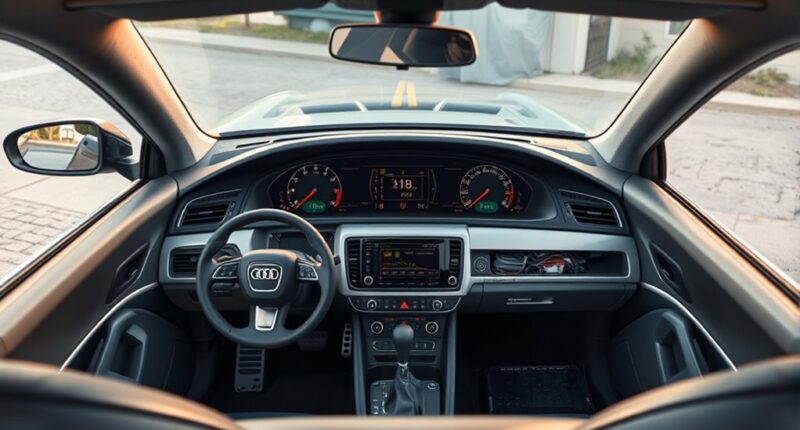To retrofit a virtual cockpit on your older Audi, you’ll need a compatible digital instrument cluster, wiring harnesses, and possibly a controller to support your vehicle’s electronics. Begin by disconnecting the battery, removing the existing gauges, and carefully installing the new digital display according to instructions. Reprogramming or calibration may be required for full functionality. For detailed steps and essential tips, continue exploring the process to guarantee a successful upgrade.
Key Takeaways
- Verify model compatibility and select a retrofit kit designed specifically for your Audi model and year.
- Disconnect the vehicle battery before removing the existing instrument cluster to ensure safety.
- Install the digital instrument cluster and wiring harnesses carefully following manufacturer instructions or professional guidance.
- Recalibrate or reprogram the system if necessary to ensure full functionality and accurate data display.
- Consider professional installation for complex wiring and calibration to achieve optimal results and avoid potential issues.

If you own an older Audi and wish to modernize its interior, retrofitting a virtual cockpit is a practical upgrade. This transformation gives your vehicle a sleek, contemporary look and enhances driving experience with advanced digital displays. The key component is a digital instrument cluster, which replaces traditional analog gauges with a high-resolution screen that can display navigation, media, and vehicle information dynamically. While Audi’s newer models come with this feature stock, older models lack it, but you can still achieve a similar upgrade through aftermarket retrofit options.
To start, you’ll need to research compatible digital instrument clusters designed specifically for your Audi model. Many aftermarket vendors offer retrofit kits that include the display, wiring harnesses, and sometimes new controllers or modules to support compatibility. These kits are engineered to fit within your existing dashboard framework, so installation typically involves removing the factory instrument cluster and replacing it with the digital unit. In some cases, you may need to modify or adapt the dashboard to accommodate the new display, but high-quality retrofit options usually come with detailed instructions or professional installation services.
Research compatible digital clusters and retrofit kits designed for your Audi model for a seamless upgrade.
When considering aftermarket retrofit options, pay close attention to compatibility. Not all digital instrument clusters are universal; some are tailored for specific Audi models or years. Ensuring the chosen kit supports your vehicle’s electronic systems is essential for seamless operation. Additionally, look into whether the retrofit includes software updates or customizations, allowing you to tailor the digital display to your preferences—be it a simplified layout or a more detailed information dashboard. It is also helpful to research high-resolution displays that provide clearer visuals and better readability under various lighting conditions.
Installation involves disconnecting the vehicle’s battery to avoid electrical issues, then carefully removing the existing instrument cluster. Depending on your comfort level with car electronics, you might prefer to have a professional handle this step, as it can involve delicate wiring and precise connections. Once the new digital cluster is installed and wired correctly, you’ll need to reprogram or calibrate it to guarantee all functionalities work properly. Some aftermarket kits come with software that allows you to configure the display settings easily.
After completing the retrofit, you’ll immediately notice the crisp visuals and customizable interfaces that a digital instrument cluster provides. It not only modernizes your older Audi’s interior but also offers benefits like clearer readability in various lighting conditions and the ability to display more relevant driving data at a glance. By exploring aftermarket retrofit options thoughtfully and possibly seeking professional help, you can enjoy a high-tech upgrade that elevates your car’s interior and driving experience without buying a new vehicle.
Frequently Asked Questions
Can I Retrofit Virtual Cockpit on All Audi Models?
You wonder if you can retrofit a virtual cockpit on all Audi models. While many older Audis can accommodate this upgrade, it depends on your specific model and its Audi interior design. Car customization enthusiasts often find this upgrade worthwhile for a modern look. Check compatibility with your vehicle and consult a professional to guarantee a seamless fit. Not all models are suitable, but many do support this innovative virtual cockpit feature.
What Is the Cost of Installing Virtual Cockpit?
The cost considerations for installing a virtual cockpit vary depending on your car model and the complexity of the retrofit. Installation expenses can range from $1,500 to over $4,000, including parts and labor. Keep in mind that these costs may fluctuate based on your location and whether you choose genuine OEM parts or aftermarket options. It’s wise to get a detailed quote from a qualified technician to understand the total investment needed.
How Long Does the Retrofit Process Take?
Think of the retrofit process as tuning a vintage instrument; it takes precision and patience. The installation timeline varies, but generally, it takes about one to two days, depending on the retrofit complexity. You’ll find that experienced technicians can streamline the process, ensuring your upgrade hits all the right notes without unnecessary delays. Be prepared for a day or two of work, especially if your car needs extra modifications.
Is Special Software Required for the Retrofit?
You don’t need special software for the retrofit, but Virtual Cockpit compatibility depends on your car’s model and existing electronics. Most upgrades require aftermarket software to guarantee proper integration, calibration, and functionality. It’s vital to use the right tools to avoid issues. While some kits come with necessary software, consulting a professional guarantees you get compatible, reliable results without risking damage or errors during installation.
Will My Warranty Be Affected by the Retrofit?
Think of your warranty as a delicate thread—easily affected by changes. When you retrofit your Audi’s Virtual Cockpit, the warranty impact depends on installation quality and software compatibility. If done professionally with compatible software, it’s less likely to void your warranty. However, unauthorized modifications or software issues might raise red flags. Always consult your dealer first to confirm the retrofit won’t jeopardize your warranty coverage.
Conclusion
Retrofitting Virtual Cockpit transforms your older Audi into a modern tech marvel, enhancing driving experience and value. Did you know that upgrading your dashboard can increase resale value by up to 10%? By following these steps, you’ll enjoy cutting-edge features without buying a new car. So, don’t wait—upgrade your Audi today and stay ahead in tech and style. It’s a smart move that keeps your car current and exciting for years to come.










